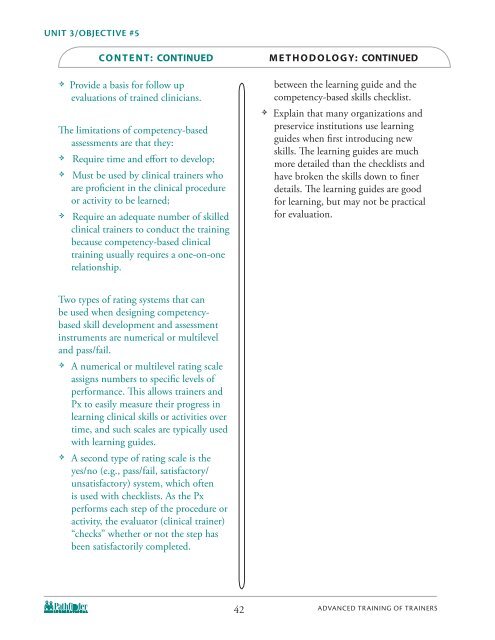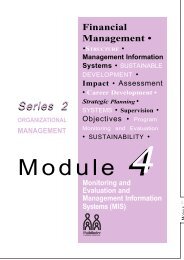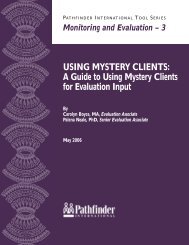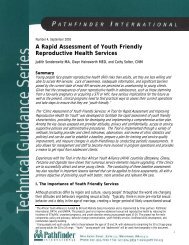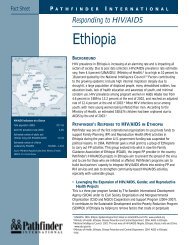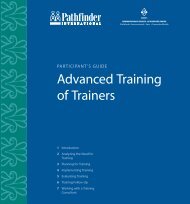Advanced Training of Trainers - Pathfinder International
Advanced Training of Trainers - Pathfinder International
Advanced Training of Trainers - Pathfinder International
You also want an ePaper? Increase the reach of your titles
YUMPU automatically turns print PDFs into web optimized ePapers that Google loves.
UNIT 3/OBJECTIVE #5<br />
CO N T E N T: CONTINUED<br />
N Provide a basis for follow up<br />
evaluations <strong>of</strong> trained clinicians.<br />
The limitations <strong>of</strong> competency-based<br />
assessments are that they:<br />
N Require time and effort to develop;<br />
N Must be used by clinical trainers who<br />
are pr<strong>of</strong>icient in the clinical procedure<br />
or activity to be learned;<br />
N Require an adequate number <strong>of</strong> skilled<br />
clinical trainers to conduct the training<br />
because competency-based clinical<br />
training usually requires a one-on-one<br />
relationship.<br />
Two types <strong>of</strong> rating systems that can<br />
be used when designing competencybased<br />
skill development and assessment<br />
instruments are numerical or multilevel<br />
and pass/fail.<br />
N A numerical or multilevel rating scale<br />
assigns numbers to specific levels <strong>of</strong><br />
performance. This allows trainers and<br />
Px to easily measure their progress in<br />
learning clinical skills or activities over<br />
time, and such scales are typically used<br />
with learning guides.<br />
N A second type <strong>of</strong> rating scale is the<br />
yes/no (e.g., pass/fail, satisfactory/<br />
unsatisfactory) system, which <strong>of</strong>ten<br />
is used with checklists. As the Px<br />
performs each step <strong>of</strong> the procedure or<br />
activity, the evaluator (clinical trainer)<br />
“checks” whether or not the step has<br />
been satisfactorily completed.<br />
42<br />
m E T h O D O lO g y: CONTINUED<br />
between the learning guide and the<br />
competency-based skills checklist.<br />
N Explain that many organizations and<br />
preservice institutions use learning<br />
guides when first introducing new<br />
skills. The learning guides are much<br />
more detailed than the checklists and<br />
have broken the skills down to finer<br />
details. The learning guides are good<br />
for learning, but may not be practical<br />
for evaluation.<br />
AdvAnced TrAining <strong>of</strong> TrAiners


